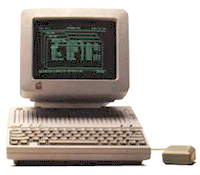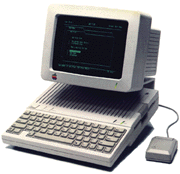History of computer design: Apple IIc
4-frogdesign || 5-Corporate focus || Conclusion || Bibliography & links
![]()
![]()
 The Apple IIc was introduced along with
the Macintosh in January 1984. To assure customers that the
older technology would not be discarded in the Macintosh
revolution, banners at its introduction proclaimed "Apple II
forever" (Levy, 223-4),
and advertisements promised "our newest brainchild is
certainly not an orphan." Apple used the established
position of the Apple II in this ad, calling the IIe "the
granddaddy of the whole personal computer industry," but its
new Apple IIc was clearly rapidly aging technology (Apple ad
in Byte, Aug. 1984, p.
0-1). Enthusiasm was revitalized through industrial design,
a revolution in appearance alongside the Mac's revolution in
function that would not fully extend to the Macintosh itself
for nearly three years.
The Apple IIc was introduced along with
the Macintosh in January 1984. To assure customers that the
older technology would not be discarded in the Macintosh
revolution, banners at its introduction proclaimed "Apple II
forever" (Levy, 223-4),
and advertisements promised "our newest brainchild is
certainly not an orphan." Apple used the established
position of the Apple II in this ad, calling the IIe "the
granddaddy of the whole personal computer industry," but its
new Apple IIc was clearly rapidly aging technology (Apple ad
in Byte, Aug. 1984, p.
0-1). Enthusiasm was revitalized through industrial design,
a revolution in appearance alongside the Mac's revolution in
function that would not fully extend to the Macintosh itself
for nearly three years.
The initial design for the IIc began before the development of Snow White by the Apple designer Rob Gemmell. Work on the machine began in December 1983 when Jobs saw Toshiba's first portable PC and agreed that Gemmell should follow a portable Apple II concept that he had long suggested. Though portable, with a handle on its back that also folds down to tilt the keyboard into a comfortable typing position, the Apple IIc does not have an integrated display and can be considered a direct descendent of the previous Apple II design. With the handle elevating the back, it tilts to the same angle as the original Apple II keyboard, and it has a similar inwards slope towards its base from the bottom of the keyboard. However, the Apple IIc is otherwise remarkably different. The playful pet-like appearance and unnecessary detailing are absent, and the familiar wedge extending out from the otherwise boxy enclosure is replaced by a simple nearly square form. This does not give a bulky appearance, though, but only emphasizes its small size: 12" long, 11.25" wide and only 2.25" high. This tablet-like shape precludes any internal expansion slots, but the IIc is as powerful as the Apple IIe, and even additionally has an integrated disk drive on its right side.
Esslinger's designers did n ot
alter Gemmell's IIc until after tooling had already begun,
so it does not have a zero-draft enclosure. In every other
way, though, it is the fullest embodiment of the language,
reverently still called by frogdesign "Snow White pure."
Apple even agreed to engineer a new keyboard for the
machine, at a cost of $200 000, to include a 2 mm radial
curve around it. The front of the unit containing the
keyboard is slightly recessed, isolating the interactive
front of the machine, but there is also a thin line around
the disk lever to make it visually apparent. Vents are
hidden within Snow White lines on the back portion. The
Apple logo on the left is balanced with the model name on
the right at the back from these lines, while the front
setback in behind the keyboard similarly balances three
buttons on the left with two LCD lights on the right. These
buttons and lights are tilted at the same angle as the
48-point Univers Italic graphics that frogdesign chose for
the keycaps, giving a hint of playfulness that is
subliminally connected to the functionality of the machine.
The keyboard itself and the disk drive lever are khaki, a
serious offset to the machine's otherwise cheerful creamy
off-white, a colour known at Apple as Fog
(Kunkel, 37-40).
ot
alter Gemmell's IIc until after tooling had already begun,
so it does not have a zero-draft enclosure. In every other
way, though, it is the fullest embodiment of the language,
reverently still called by frogdesign "Snow White pure."
Apple even agreed to engineer a new keyboard for the
machine, at a cost of $200 000, to include a 2 mm radial
curve around it. The front of the unit containing the
keyboard is slightly recessed, isolating the interactive
front of the machine, but there is also a thin line around
the disk lever to make it visually apparent. Vents are
hidden within Snow White lines on the back portion. The
Apple logo on the left is balanced with the model name on
the right at the back from these lines, while the front
setback in behind the keyboard similarly balances three
buttons on the left with two LCD lights on the right. These
buttons and lights are tilted at the same angle as the
48-point Univers Italic graphics that frogdesign chose for
the keycaps, giving a hint of playfulness that is
subliminally connected to the functionality of the machine.
The keyboard itself and the disk drive lever are khaki, a
serious offset to the machine's otherwise cheerful creamy
off-white, a colour known at Apple as Fog
(Kunkel, 37-40).
The Apple IIc was immediately popular, receiving the highest first-day orders in Apple's history. By the end of 1984, over 400 000 had been sold, most with the zero-draft display which Apple and frogdesign designed to be cantilevered by a stand over the back of the computer. This popularity was driven in large part by its appearance; the IIc was the first Apple product to receive formal recognition for its industrial design, for which it won several prestigious awards (Kunkel, 40).
To a Corporate focus
(1986-89) ![]()
Home || Introduction || Historiography || 1-Cottage industry || 2-Emerging standards || 3-Macintosh
4-frogdesign || 5-Corporate focus || Conclusion || Bibliography & links







.jpg)








